Warsaw Ghetto
| Warsaw Ghetto | |
|---|---|
|
Right to left: Warsaw Ghetto, Ghetto wall, Iron-Gate Square, Lubomirski Palace, 24 May 1941. | |
| Also known as | German: Ghetto Warschau |
| Location |
Warsaw: Muranów, Powązki, Nowolipki, Śródmieście Północne, Mirów (German-occupied Poland) |
| Date | October 1940 to May 1943 |
| Incident type | Imprisonment, mass shootings, forced labor, starvation, mass deportations to Treblinka and labour camps in the Lublin District |
| Perpetrators | Nazi Germany |
| Organizations |
|
| Camp | Treblinka |
| Victims | 400,000 Polish Jews; also Jews deported from Germany, and Czechoslovakia |
| Documentation |
Jewish Historical Institute Museum of the History of the Polish Jews |
The Warsaw Ghetto[1] (German: Warschauer Ghetto, called by the German authorities Jüdischer Wohnbezirk in Warschau, Jewish residential district in Warsaw; Polish: getto warszawskie) was the largest of all the Jewish ghettos in Nazi-occupied Europe during World War II. It was established in the Muranów neighborhood of the Polish capital between October and November 16, 1940, part of the territory of the General Government of German-occupied Poland, with over 400,000 Jews from the vicinity residing in an area of 3.4 km2 (1.3 sq mi). From there, at least 254,000 Ghetto residents were sent to the Treblinka extermination camp over the course of two months in the summer of 1942.
The death toll among the Jewish inhabitants of the Ghetto, between starvation, disease, deportations to extermination camps, Großaktion Warschau, the Warsaw Ghetto Uprising, and the subsequent razing of the ghetto, is estimated to be at least 300,000.[2][3][4][5]
Creation
The construction of the ghetto wall started on April 1, 1940.[6] The Warsaw Ghetto was established by the German Governor-General Hans Frank on October 16, 1940 in an area of Warsaw primarily occupied by Polish Jews. Frank ordered all Jews in Warsaw and its suburbs rounded up and herded into the Ghetto. At this time, the population in the Ghetto was estimated to be 400,000 people, about 30% of the population of Warsaw;[7] however, the area of the Ghetto was only about 2.4% of that of Warsaw.[8]
The Germans closed the Warsaw Ghetto to the outside world on November 15, 1940.[9] The wall was typically 3 m (9.8 ft) high and topped with barbed wire. Escapees could be shot on sight. The borders of the ghetto changed many times during the next years.

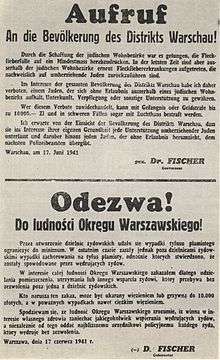
The ghetto was divided by Chłodna Street, which due to its importance (as one of Warsaw's major east-west arteries) was excluded from it. The area south of Chłodna was known as the “Small Ghetto”, while the area north of this street was the “Large Ghetto”. Those two parts were connected by Żelazna Street, and a special gate was built at its intersection with Chłodna Street. In January 1942, the gate was closed and a wooden footbridge was built in its place, which after the war became one of the symbols of the Holocaust.[10] The first commissioner of the Warsaw ghetto was his chief organizer SA-Standartenführer Waldemar Schön. He was succeeded in May 1941 by Heinz Auerswald.
Administration of the Ghetto
Like all the ghettos in Poland, the Germans ascribed the administration to a Judenrat (a council of the Jews), led by an "Ältester" (the eldest).[11] In Warsaw this role was attributed to Adam Czerniaków, who chose a policy of collaboration with the Nazis rather than revolt. Adam Czerniaków confided his harrowing experience in several diaries.[12] He became aware of his own tragic duplicity in July 1942 and committed suicide.
Although his personality has remained less infamous than Mordechai Chaim Rumkowski, the "Ältester" of the Lodz Ghetto, Adam Czerniaków's collaboration with the Nazi policy is the paradigm of the attitude of the majority of the European Jews vis à vis Nazism. The Jewish collaboration authority was supported by a Jewish Ghetto Police. According to Lucy S. Dawidowicz:
From its inception, the Judenrat was looked upon as a reincarnation of the kehillas. Czerniakow's first draft of October, 1939; for organizing the Warsaw Judenrat, was just a rehash of conventional kehilla departments: chancellery, welfare, education, rabbinate...
In performing these functions, the kehilla had operated a "gemeinschaft" institution... But the Kehilla was an anomalous institution. Throughout its history in czarist Russia, it served also as an instrument of the state, obligated to carry out the regime's policies within the Jewish community, even though these policies were frequently oppressive and specifically anti-Jewish...[13]
Conditions
During the next year and a half, thousands of Polish Jews as well as some Romani people from smaller cities and the countryside were brought into the Ghetto, while diseases (especially typhus),[14] and starvation kept the inhabitants at about the same number. Average food rations in 1941 for Jews in Warsaw were limited to 184 calories, compared to 699 calories for gentile Poles and 2,613 calories for Germans.[15]
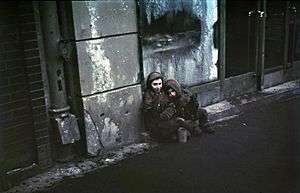
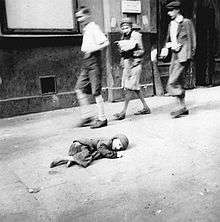
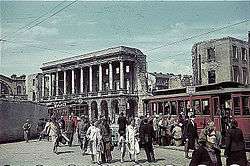
Unemployment was a major problem in the ghetto. Illegal workshops were created to manufacture goods to be sold illegally on the outside and raw goods were smuggled in, often by children. Hundreds of four- to eight-year-old Jewish children went across en masse to the "Aryan side," sometimes several times a day, smuggling food into the ghettos, returning with goods that often weighed more than they did. Smuggling was often the only source of subsistence for Ghetto inhabitants, who would otherwise have died of starvation.
Despite the grave hardships, life in the Warsaw Ghetto was rich with educational and cultural activities, conducted by its underground organizations. Hospitals, public soup kitchens, orphanages, refugee centers and recreation facilities were formed, as well as a school system. Some schools were illegal and operated under the guise of a soup kitchen. There were secret libraries, classes for the children and even a symphony orchestra. Rabbi Alexander Zusia Friedman, secretary-general of Agudath Israel of Poland, was one of the Torah leaders in the Warsaw Ghetto. He organized an underground network of religious schools, including "a Yesodei HaTorah school for boys, a Bais Yaakov school for girls, a school for elementary Jewish instruction, and three institutions for advanced Jewish studies". These schools, operating under the guise of kindergartens, medical centers and soup kitchens, were a place of refuge for thousands of children and teens, and hundreds of teachers. In 1941, when the Germans gave official permission to the local Judenrat to open schools, these schools came out of hiding and began receiving financial support from the official Jewish community.[16]
Over 100,000 of the Ghetto's residents died due to rampant disease or starvation, as well as random killings, even before the Nazis began massive deportations of the inhabitants from the Ghetto's Umschlagplatz to the Treblinka extermination camp during the Grossaktion Warschau, part of the countrywide Operation Reinhard. Between Tisha B'Av (July 23) and Yom Kippur (September 21) of 1942, about 254,000 Ghetto residents (or at least 300,000 by different accounts)[7] were sent to Treblinka and murdered there.[17]
Friedman alerted world Jewry to the start of deportations from the Warsaw Ghetto in a coded message. His telegram read: "Mr. Amos kept his promise from the fifth-third." He was referring to the Book of Amos, chapter 5, verse 3, which reads: "The city that goes out a thousand strong will have a hundred left, and the one that goes out a hundred strong will have ten left to the House of Israel".[18]
Polish resistance officer Jan Karski reported to the Western governments in 1942 on the situation in the Ghetto and on the extermination camps. By the end of 1942, it was clear that the deportations were to their deaths, and many of the remaining Jews decided to fight.[7]
For years, Ghetto residents in the group Oyneg Shabbos had discreetly chronicled conditions and hid their photos, writings, and short films in improvised time capsules; their activity increased after learning that transports to "resettlement" actually led to the mass killings. In May 1942, Germans began filming a propaganda movie titled "Das Ghetto" which was never completed. Footage is shown in the 2010 documentary called "A Film Unfinished" which concerns the making of "Das Ghetto" and correlates scenes from 'Das Ghetto' with descriptions of the filming of these scenes that Czerniakow mentions in his diary.
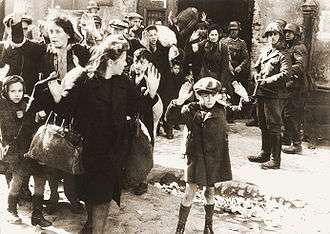
Warsaw Ghetto Uprising and destruction of the Ghetto
On January 18, 1943, after almost four months without any deportations, the Germans suddenly entered the Warsaw ghetto intent upon a further deportation. Within hours, some 600 Jews were shot and 5,000 others rounded up.
The Germans expected no resistance, but preparations to resist had been going on since the previous autumn.[19] The first instances of Jewish armed resistance began that day. The Jewish fighters had some success: the expulsion stopped after four days and the ŻOB and ŻZW resistance organizations took control of the Ghetto, building shelters and fighting posts and operating against Jewish collaborators.[14]
The final battle started on the eve of Passover of April 19, 1943, when a Nazi force consisting of several thousand troops entered the ghetto. After initial setbacks, the Germans under the field command of Jürgen Stroop systematically burned and blew up the ghetto buildings, block by block, rounding up or murdering anybody they could capture. Significant resistance ended on April 28, and the Nazi operation officially ended in mid-May, symbolically culminating with the demolition of the Great Synagogue of Warsaw on May 16. According to the official report, at least 56,065 people were killed on the spot or deported to German Nazi concentration and death camps (Treblinka, Poniatowa, Majdanek, Trawniki).

Remnants of the Ghetto today
The ghetto was almost entirely leveled during the uprising; however, a number of buildings and streets survived, mostly in the "small ghetto" area, which had been included into the Aryan part of the city in August 1942 and was not involved in the fighting. In 2008 and 2010 Warsaw Ghetto boundary markers were built along the borders of the former Jewish quarter, where from 1940−1943 stood the gates to the ghetto, wooden footbridges over Aryan streets, and the buildings important to the ghetto inmates. The four buildings at 7, 9, 12 and 14 Próżna Street are among the best known original residential buildings that in 1940-41 housed Jewish families in the Warsaw Ghetto. They have largely remained empty since the war. The street is a focus of the annual Warsaw Jewish Festival. In 2011−2013 buildings at number 7 and 9 underwent extensive renovations and have become office space.
The Nożyk Synagogue also survived the war. It was used as a horse stable by the German Wehrmacht. The synagogue has today been restored and is once again used as an active synagogue. The best preserved fragments of the ghetto wall are located 55 Sienna Street, 62 Złota Street, and 11 Waliców Street (the last two being walls of the pre-war buildings). There are two Warsaw Ghetto Heroes' monuments, unveiled in 1946 and 1948, near the place where the German troops entered the ghetto on 19 April 1943. In 1988 a stone monument was built to mark the Umschlagplatz.
There is also a small memorial at ul. Mila 18 to commemorate the site of the Jewish underground headquarters during the Ghetto Uprising. In December 2012, a controversial statue of a kneeling and praying Adolf Hitler was installed in a courtyard of the Ghetto. The artwork by Italian artist, Maurizio Cattelan, entitled "HIM", has received mixed reactions worldwide. Many feel that it is unnecessarily offensive, while others, such as Poland's chief rabbi, Michael Schudrich, feel that is thought-provoking, even "educational".[20]
Photographs
-
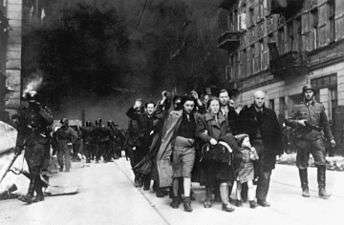
Stroop Report. Photo shows Ghetto buildings burning while Germans march the Jews
-

Walling-off Świętokrzyska Street (seen from Marszałkowska Street on the "Aryan side")
-
Remnant of Warsaw Ghetto wall behind a house at Sienna Street 55
-
Ghetto wall remnant behind a house at 62 Złota Street
-
Former ghetto wall at 11 Waliców Street
-
Miła 18 memorial
-
One of 22 Warsaw Ghetto boundary markers
-

Tombstone in Warsaw Insurgents Cemetery of remains of 6588 Jewish persons executed at RKS Skra Stadium
People of the Warsaw Ghetto
Casualties
- Tosia Altman - ghetto resistance fighter, escaped the Ghetto in 1943 uprising through the sewers. Died afterwards after she was caught by the Gestapo when the celluloid factory where she hid caught fire.
- Mordechaj Anielewicz - ghetto resistance leader in the ŻOB (alias Aniołek). Died with many of his comrades at their surrounded command post.
- Dawid Moryc Apfelbaum - ghetto resistance leader and commander of the ŻZW. Killed in action during the ghetto uprising.[21]
- Maria Ajzensztadt - singer known as the Nightingale of the Ghetto
- Adam Czerniaków - engineer and senator, head of the Warsaw Judenrat (Jewish council). Committed suicide in 1942.
- Yitzhak Gitterman - director of the American Jewish Joint Distribution Committee in Poland, resistance fighter. Killed in action during the ghetto uprising.
- Itzhak Katzenelson - teacher, poet, dramatist and resistance fighter. Executed at Auschwitz-Birkenau in 1944.
- Janusz Korczak - children's author, pediatrician, child pedagogist and orphanage owner. Executed along with his orphans at Treblinka in August, 1942, after refusing an offer to leave his orphans and escape.
- Simon Pullman - conductor of the Warsaw Ghetto symphony orchestra. Executed at Treblinka in 1942.
- Emanuel Ringelblum - historian, politician and social worker, leader of the Ghetto chroniclers. Discovered in Warsaw and executed together with his family in 1944.
- Kalonymus Kalman Shapira - grand rabbi of Piaseczno. Executed at Trawniki during Aktion Erntefest in 1943.
- Władysław Szlengel - poet of the Warsaw ghetto; killed in 1943 uprising.
- Lidia Zamenhof - Esperantist, daughter of Dr. L. L. Zamenhof. Executed at Treblinka in 1942.
- Nathalie Zand - Neurologist and research scientist. Practised as a doctor within the ghetto. Thought to have been executed at Pawiak prison, September 1942.
Survivors
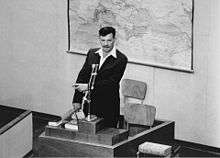
- Mary Berg, diarist, daughter of a mother who was an American citizen. One of a group of Warsaw Ghetto internees exchanged for German POWs in March, 1944. Her story is recounted in The Diary of Mary Berg, first published in 1945 and republished in 2007.
- Adolf Berman – leader in Jewish Underground in Warsaw; member of Zegota and Centos-died 1978
- Icchak Cukierman – ghetto resistance leader ("Antek"), founder of the Lohamei HaGeta'ot kibbutz in Israel. Died in 1981.
- Marek Edelman – Polish political and social activist, cardiologist. He was the last surviving leader of the ŻOB. Died in 2009.
- Jack P. Eisner – Author of "The Survivor of the Holocaust". The young boy who hung the Jewish flag atop the burning building in the Warsaw Ghetto Uprising. ZZW fighter. Commemorator of the holocaust. Died in 2003.[22]
- Ruben Feldschu (Ben Shem) (1900–1980) – Zionist author and political activist[23]
- Joseph Friedenson – Editor of Dos Yiddishe Vort. Died in 2013.
- Bronisław Geremek – Polish social historian and politician. Died in 2008.
- Martin Gray – Soviet secret police officer and American and French writer.
- Mietek Grocher – Swedish author and the Holocaust remembrance activist.
- Alexander J. Groth – Professor of Political Science at the University of California, Davis. Author of Lincoln: Authoritarian Savior and Democracies Against Hitler: Myth, Reality and Prologue, Holocaust Voices, Accomplices: Roosevelt, Churchill and the Holocaust.
- Ludwik Hirszfeld – Polish microbiologist and serologist, died in 1954.
- Morton Kamien – Polish-American economist, died in 2011.
- Zivia Lubetkin – ghetto resistance leader, Aliyah Bet activist, later married Cukierman. Died in 1976.
- Vladka Meed – ghetto resistance member; author. Died in 2012.
- Uri Orlev – Israeli author of the semi-autobiographical novel The Island on Bird Street recounting his experiences in the Warsaw Ghetto.
- Marcel Reich-Ranicki – German literary critic. Died in 2013.
- Sol Rosenberg – American steel industrialist and philanthropist. Died in 2009.[24]
- Simcha Rotem – ghetto resistance fighter ("Kazik"), Berihah activist, post-war Nazi hunter.
- Uri Shulevitz – book illustrator
- Władysław Szpilman – Polish pianist, composer and writer, subject of the film The Pianist by Roman Polanski (survivor of the Kraków Ghetto) based on his memoir. Died in 2000.
- Menachem Mendel Taub – Kaliver rabbi in Israel.
- Dawid Wdowiński – psychiatrist, political leader of the Irgun in Poland, resistance leader of the ŻZW, American memoirist. Died in 1970.
Associated people
- Władysław Bartoszewski - Polish resistance activist of the Żegota organization in Warsaw.
- Henryk Iwański - Polish resistance officer in the charge of support for the Ghetto. Died in 1978.[25]
- Jan Karski - Polish resistance courier who reported on the Ghetto for the Allies. Died in 2000.
- Zofia Kossak-Szczucka - was a Polish writer and World War II resistance fighter and co-founder of Żegota. Died in 1968.
- Irena Sendler - Polish resistance member who smuggled 2,500 Jewish children out of the Ghetto and helped to hide them, subject of the film The Courageous Heart of Irena Sendler. Died in 2008.
- Szmul Zygielbojm - Polish-Jewish socialist politician. In 1943 committed suicide in London in an act of protest against the Allied indifference to the death of the Warsaw Ghetto.
See also
- Adam Czerniaków - Head of Warsaw Judenrat (1939-1942)
- Ghettos in occupied Europe 1939-1944
- Great Synagogue in Warsaw - One of the largest synagogues in the world, demolished in 1943
- Grossaktion Warschau - The massive deportation to Treblinka in 1942
- Group 13 - Jewish collaborationist secret police also known as Jewish Gestapo, led by Abraham Gancwajch
- Heinz Auerswald - Commissioner for the Jewish residential district in Warsaw
- Hermann Höfle - A deputy to Globocnik
- Jewish Ghetto Police - Jewish collaborationist police force in Warsaw Ghetto and elsewhere
- Jürgen Stroop - Nazi commander during the suppression of the uprising
- Miła 18 - place of mass suicide of Mordechai Anielewicz and other leaders of Warsaw Ghetto Uprising
- Mila 18 - A book by Leon Uris
- Muranów - a district in Warsaw where the major part of the Ghetto was built
- Odilo Globocnik - The Nazi leader responsible for the liquidation of the Ghetto
- The Silver Sword - A novel focused on a family from Warsaw during the Second World War
- Timeline of Treblinka
- Umschlagplatz - Collection point for the deportations to extermination camps
- Warsaw concentration camp - The concentration camp established in the former Ghetto
- Warschauer Kniefall - Gesture by Chancellor of Germany Willy Brandt
- Żagiew - A group of collaborators posing as a resistance group (see also Hotel Polski affair)
References
- ↑ Megargee, Geoffrey P., ed. (2009). The United States Holocaust Memorial Museum encyclopedia of camps and ghettos, 1933–1945. Volume II: Ghettos in German-occupied Eastern Europe. Bloomington: Indiana University Press. pp. 456–460. ISBN 978-0-253-35599-7.
- ↑ United States Holocaust Memorial Museum, Warsaw Ghetto Uprising Last Updated: May 20, 2008.
- ↑ Aktion Reinhard. Treblinka Extermination Camp in the Generalgouvernement. Yad Vashem.
- ↑ (Polish) Marcin Urynowicz, Institute of National Remembrance (IPN), Gross Aktion – Zagłada Warszawskiego Getta (Gross Aktion – Annihilation of Warsaw Ghetto)
- ↑ The statistical data compiled on the basis of "Glossary of 2,077 Jewish towns in Poland" by Virtual Shtetl Museum of the History of the Polish Jews (English), as well as "Getta Żydowskie," by Gedeon, (Polish) and "Ghetto List" by Michael Peters at www.deathcamps.org/occupation/ghettolist.htm (English). Accessed June 21, 2011.
- ↑ Adama Czerniakowa dziennik getta warszawskiego 6 IX 1939 – 23 VII 1942, Opracowanie i przypisy Marian Fuks, Państwowe Wydawnictwo Naukowe, Warszawa 1983, p. 101
- 1 2 3 "Warsaw Ghetto Uprising", United States Holocaust Memorial Museum. Last Updated: May 20, 2008.
- ↑ The Warsaw Ghetto
- ↑ Berg, Mary (1945). Warsaw Ghetto: A Diary by Mary Berg. New York: L. B. Fischer Publishing Corp. p. 38.
- ↑ http://www.johndclare.net/Nazi_Germany3_WarsawGhetto.htm
- ↑ cf Dawidowicz, Lucy S. (1975). The war against the Jews 1933-1945. New York: Holt, Rinehart and Winston. pp. 228–229.
- ↑ Hilberg, Raul, et al. (editors). The Warsaw diary of Adam Czerniakow: Prelude to Doom (Stein & Day, NY, 1979).
- ↑ Dawidowicz op.cit.
- 1 2 (English) David Wdowiński (1963). And we are not saved. New York: Philosophical Library pp. 222. ISBN 0-8022-2486-5. Note: Chariton and Lazar were never co-authors of Wdowiński's memoir. Wdowiński is considered the "single author."
- ↑ Roland, Charles G, "Scenes of Hunger and Starvation" (1992), pages 99-104.
- ↑ Seidman, Hillel. "Alexander Zusia Friedman", in Wellsprings of Torah: An Anthology of Biblical Commentaries, Vol. 1. Nison L. Alpert, ed. The Judaica Press, Inc., 1974, pp. xii–xxiii.
- ↑ Treblinka, Yad Vashem
- ↑ Farbstein, Esther (2007). Hidden in Thunder: Perspectives on faith, halachah and leadership during the Holocaust. 1. Feldheim Publishers. p. 31. ISBN 9789657265055.
- ↑ Martin Gilbert, 'The Holocaust' (1986), pages 522-523.
- ↑ ""Controversy over Adolf Hitler statue in Warsaw ghetto"". The Guardian. 2012-12-28. Retrieved 2016-08-11.
- ↑ Though Apfelbaum is listed in many books and articles devoted to the revolt in the Warsaw Ghetto as one of the commanders of the Jewish Military Union (for example, see Moshe Arens, "The Development of the Narrative of the Warsaw Ghetto Uprising," Israel Affairs, Vol.14, No.1, January 2008), and a square was named for him in Warsaw, historians Dariusz Libionka and Laurence Weinbaum have cast doubt about his existence (see Dariusz Libionka & Laurence Weinbaum, "A legendary commander," Haaretz, 22 June 2007, http://www.haaretz.com/weekend/magazine/a-legendary-commander-1.223769)
- ↑ The historians Dariusz Libionka and Laurence Weinbaum maintain that Eisner's memoir, 'The Survivor' (published in 1980) is riddled with inconsistencies and even its author's own fantasies, and as such cannot be regarded as serious survivor testimony and a credible source of information on the uprising.
- ↑ Laurence Weinbaum, "Shaking the Dust Off" The Story of the Warsaw Ghetto's Forgotten Chronicler, Jewish Political Studies Review Vol. 22 No. 3-4 (Fall 2010).
- ↑ "Businessman Sol Rosenthal dies", Monroe News Star, Monroe, Louisiana, January 31, 2009
- ↑ Though he succeeded in convincing a number of historians of the veracity of his story, as well as the American journalist Dan Kurzman, according to new research by a Polish-Israeli team of historians, Iwanski's accounts of his own herosim (and his claims to have sustained the loss of several family members during the revolt) belong in the realm of confabulation. See: Dariusz Libionka, Laurence Weinbaum: "Bohaterowie, hochsztaplerzy, opisywacze - Wokół Żydowskiego Związku Wojskowego", Stowarzyszenie Centrum Badań nad Zagładą Żydów, Warsaw 2011
Bibliography
- Mary Berg, The Diary of Mary Berg: Growing Up in the Warsaw Ghetto, Oxford: Oneworld Publications, 2007 (2nd ed), ISBN 1-85168-472-7 (1st ed: Warsaw Ghetto: a diary by Mary Berg, New York: L.B. Fischer, 1945; translated by Norbert Guterman; edited by S.L. Shneiderman; a "war time book")
- Marek Edelman, The Ghetto Fights, London: Bookmarks, 1994, ISBN 0-906224-56-X
- Israel Gutman, Resistance: The Warsaw Ghetto Uprising, ISBN 0-395-60199-1
- Martin Gray, For Those I Loved, ISBN 0-316-32576-7
- Raul Hilberg, et al. (editors). The Warsaw diary of Adam Czerniakow: Prelude to Doom (Stein & Day, NY, 1979).
- Janusz Korczak, Ghetto diary, ISBN 978-0-89604-004-5
- Dariusz Libionka, Laurence Weinbaum: "Bohaterowie, hochsztaplerzy, opisywacze - Wokół Żydowskiego Związku Wojskowego", Stowarzyszenie Centrum Badań nad Zagładą Żydów, Warsaw 2011
- Emmanuel Ringelblum, Notes from the Warsaw Ghetto, New York: ibooks, 2006, ISBN 1-59687-331-0
- Władysław Szpilman, The Pianist: The Extraordinary True Story of One Man's Survival in Warsaw, 1939-1945, ISBN 0-312-31135-4
- Dawid Wdowiński, And We Are Not Saved, ISBN 978-0-8022-2486-6, The Warsaw Ghetto: A Guide to the Perished City, ISBN 978-0-300-11234-4
- Barbara Engelking & Jacek Leociak, The Warsaw Ghetto: A Guide to the Perished City, ISBN 978-0-300-11234-4
- Warsaw and Ghetto, Warsaw: B&M Potyralski, 2000, ISBN 83-901501-2-3
External links
| Wikimedia Commons has media related to Warsaw Ghetto. |
- Photographs from the Warsaw Ghetto - Online exhibition from Yad Vashem
- Warsaw Ghetto from Holocaust Survivors and Remembrance Project: "Forget You Not"
- Historical Sites of Jewish Warsaw
- Warsaw Ghetto Internet Database hosted by Polish Center for Holocaust Research
- Detailed, interactive map of the Warsaw Ghetto plotted on pre-war plan of the city
- Documents and information about the Warsaw Ghetto from the Jewish Virtual Library
- Yad Vashem - About the Holocaust - The Warsaw Ghetto
- Warsaw Ghetto poems from the Ringelblum Archive
- Lecture on Emanuel Ringelblum and the Warsaw Ghetto Dr. Henry Abramson
- Artists of the Warsaw Ghetto
- The ramparts of Warsaw 1943-44 (documentary film) by André Bossuroy, 2014, programme 'Active European Remembrance' of the European Commission.
Coordinates: 52°14′46″N 20°59′45″E / 52.24611°N 20.99583°E
